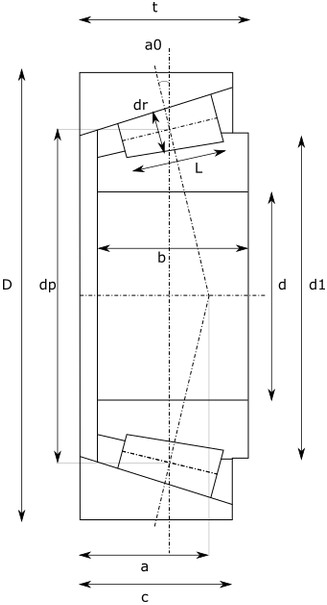TaperedRollerBearing
Model ElementSpecifies an analytical bearing that overtakes the radial and axial loads in one direction.
Class Name
TaperedRollerBearing
Description
The bearing is defined by the following dimensions:

Figure 1.
Attributes
The table below summarizes the attributes of the TaperedRollerBearing classes.
| Variable | Type | Notes | Figure Symbol |
|---|---|---|---|
| id | Int() | Unique identification number. | |
| label | Str() | Descriptor of the bearing element. | |
| rm | Reference("Marker", required=True) | The reference marker of the bearing element. This marker points to the center of the bearing. Defines the orientation of the bearing (z axis of reference marker is the bearing axial axis). The positive z axis should be on the direction that the bearing carries the axial load, if it is loaded on inner ring (oriented to the left in the figure). The rm part must always be on the housing of the system. |
|
| number_of_rollers | Int(required=True) | The number of rolling elements in the bearing. | |
| pitch_diameter | Double(required=True) | The pitch diameter of the bearing. | dp |
| contact_angle | Double(required=True) | The contact angle of the bearing. Defined in degrees [deg]. |
a0 |
| width_a | Double() | The pressure point distance. The default value is calculated internally as a function of pitch diameter, width_t, and contact angle | a |
| width_b | Double() | The inner ring width. The default value is calculated internally as a function of width_t. | b |
| width_c | Double() | The outer ring width. The default value is calculated internally as a function of width_b. | c |
| width_t | Double(required=True) | Total bearing width. | t |
| inner_shoulder_diameter | Double() | Bearing inner shoulder diameter, as shown on the figure above. The default value is calculated internally as a function of the pitch diameter. | d1 |
| inner_diameter | Double(required=True) | The inner diameter of the bearing. | d |
| outer_diameter | Double(required=True) | The outer diameter of the bearing. | D |
| roller_diameter | Double(required=True) | The rolling element diameter. | dr |
| roller_length | Double(required=True) | The rolling element length. | L |
| effective_roller_length | Double(required=True) | The rolling element effective length (the length that the contact occurs). | |
| bearing_density | Double() | The density of the bearing parts. See Comment 2. | |
| roller_pass_frequency | Bool (True) | Defines if the bearing rotates with the inner and outer shaft. Default is set to True. Deactivating the rotation improves the computational performance, but neglects excitations caused by rollers passing through the loading zone. | |
| friction_torque | Bool (False) | Activates the friction torque of the bearing. | |
| simplified_graphics | Bool (False) | Creates simplified graphics for bearing rings and avoids graphics for rollers. This can reduce the H3D file size for large models. | |
| rollers_force_graphics | Bool (False) | Activates force vector graphics in the rolling elements. | |
| vec_gra_scale | Double(1.0) | Scales the rollers force vector graphics. | |
| damping_force | Bool (True) | Activates the damping force in the bearing. | |
| output_rm | Reference("Marker") | Defines the reference marker in which the output results are
written. The default value is the defined bearing reference marker (rm). |
|
| damping_ratio | Double(0.1) | The damping ratio of bearing. This value must be between 0.0-1.0. | |
| bearing_k_factor | Double(0.0) | Expresses the ratio of the basic dynamic thrust load rating
and basic dynamic radial load rating (Y/X) where: P = X · Fr + Y · Fa is the basic dynamic equivalent radial load (example value X = 0.4, Y = 1.53, K = 3.825). It is used in the friction torque calculation. |
|
| lubricant_viscosity | Double(0.0) | The lubricant viscosity of the bearing in [cSt]. It is used in the friction torque calculation. | |
| transition_velocity | Double(0.1) | The angular velocity at which the friction torque takes full effect [rad/sec]. Friction is ramped up smoothly from 0 until the transition velocity for solver stability. | |
| inner_connection_part | Reference("Part", required=True) | The part/shaft that connects to the outer ring. See Comment 1. | |
| outer_connection_part | Reference("Part", required=True) | The part/shaft that connects to the outer ring. See Comment 1. | |
| na | Int(60) | Defines the number of nodes in the perimeter of the ring graphics. | |
| nc | Int(6) | Defines the number of nodes in the raceway of the ring graphics. | |
| no | Int(2) | Defines the number of nodes in the width of the ring graphics. |
Example
b = TaperedRollerBearing(
id=1,
label='bearing',
rm=Marker(part=ground),
number_of_rollers=19,
pitch_diameter=36.0,
contact_angle=16,
width_a=11.433,
width_b=15,
width_c=11.5,
width_t=15,
inner_shoulder_diameter=37.5,
inner_diameter=25.0,
outer_diameter=47.0,
roller_diameter=5.3,
roller_length=10.7,
effective_roller_length=9.93,
bearing_density= 7.85e-06,
roller_pass_frequency=True,
friction_torque=True,
damping_force=True,
damping_ratio=0.1,
bearing_k_factor=3.5,
lubricant_viscosity=80,
inner_connection_part=b_shaft,
outer_connection_part=B_Ground,
)